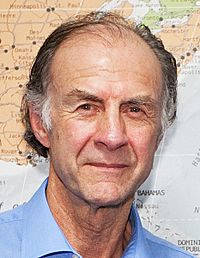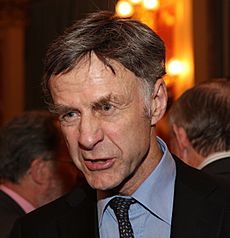Ranulph Fiennes facts for kids
Quick facts for kids
Ranulph Fiennes
|
|
|---|---|

Fiennes in 2014
|
|
| Born |
Ranulph Twisleton-Wykeham-Fiennes
7 March 1944 Windsor, Berkshire, England
|
| Alma mater | Mons Officer Cadet School |
| Occupation | British Army Officer; explorer and travel writer |
| Spouse(s) |
Ginny Pepper
(m. 1970; died 2004)Louise Millington
(m. 2005) |
| Children | 1 |
| Awards |
|
| Military career | |
| Allegiance | United Kingdom |
| Service/ |
British Army |
| Years of service | 1963–1983 |
| Rank | Lieutenant |
| Service number | 474357 |
| Unit |
|
Sir Ranulph Fiennes is a famous British explorer, writer, and poet. He is known for holding many endurance records. He was the first person to reach both the North Pole and South Pole by traveling over land. He was also the first to cross Antarctica completely on foot. In May 2009, when he was 65, he even climbed to the top of Mount Everest.
The Guinness Book of World Records called him the world's greatest living explorer in 1984. Sir Ranulph has written many books about his time in the army and his amazing expeditions.
Contents
Early Life and School
Ranulph Fiennes was born in Windsor, England, on March 7, 1944. This was almost four months after his father, Lieutenant-Colonel Sir Ranulph Twisleton-Wykeham-Fiennes, passed away. His father was leading the Royal Scots Greys in Italy during World War II. He stepped on a German mine and died from his injuries in November 1943.
After the war, Ranulph's mother moved the family to South Africa. He lived there until he was 12 years old. He went to Western Province Preparatory School in Newlands, Cape Town. Later, he returned to England and studied at Sandroyd School and then Eton College.
Amazing Adventures and Career

Becoming an Officer
Ranulph Fiennes wanted to join the army. He went to Mons Officer Cadet School and became an officer in 1963. He joined his father's old regiment, the Royal Scots Greys. He later worked with the Special Air Service (SAS), where he learned about demolitions (blowing things up safely).
Once, he got into trouble for trying to blow up a temporary dam. This dam was built for a movie called Doctor Dolittle in 1967. The police stopped his plan, and he was fined. He was also dismissed from the SAS for a short time.
Fiennes spent his last two years in the army helping the Sultan of Oman's Armed Forces. He fought in the Dhofar War and was recognized for his bravery. He left the army in 1971 after eight years of service.
Leading Expeditions
Since the 1960s, Sir Ranulph Fiennes has led many expeditions. He traveled up the White Nile in a hovercraft in 1969. In 1970, he explored the Jostedalsbreen Glacier in Norway.
One of his most famous journeys was the Transglobe Expedition from 1979 to 1982. He and two friends, Oliver Shepard and Charles R. Burton, traveled all the way around the world. They followed the Earth's polar axis, using only surface transport. No one else has ever done this before or since.
As part of this expedition, Fiennes and Burton completed the Northwest Passage. They traveled about 3,000 miles (4,800 km) in an open boat. This was the first time anyone had crossed it from west to east in an open boat.
In 1992, Fiennes led a team that found what might be a lost city called Iram in Oman. The next year, he and nutrition expert Mike Stroud became the first to cross the Antarctic continent without outside help. This journey took them 93 days.
In 2000, he tried to walk to the North Pole alone. But his sleds fell through thin ice, and he had to pull them out by hand. He got severe frostbite on his left hand. When he got home, he even cut off his own frostbitten fingertips because they were causing him so much pain.
Even after having a heart attack and a double bypass operation, Fiennes joined Mike Stroud again in 2003. They completed seven marathons in seven days on seven continents. This was for the British Heart Foundation. He later said he wouldn't do it again because it was so hard.
In June 2005, Fiennes tried to climb Mount Everest again. He had to turn back because of heart problems. In March 2007, he climbed the Eiger in the Alps, even though he had a lifelong fear of heights. This climb raised £1.8 million for charity.
On May 20, 2009, Fiennes reached the top of Mount Everest. He became the oldest British person to do so at the time. He also became the first person to have climbed Everest and crossed both polar ice-caps.
In September 2012, it was announced that Fiennes would lead the first attempt to cross Antarctica during the southern winter. This was for a charity called Seeing is Believing, which helps prevent blindness. However, Fiennes had to leave the expedition in February 2013 because of frostbite.
Becoming an Author
Sir Ranulph Fiennes is also a successful author. He has written 24 books, both fiction and non-fiction. One of his books, The Feather Men, was even made into a movie. In 2003, he wrote a book about Captain Robert Falcon Scott, defending his achievements as an explorer.
Media Appearances
Sir Ranulph has appeared on the British car show Top Gear. He was a "Star in a Reasonably Priced Car." He also appeared in the Top Gear: Polar Special episode, where he shared serious warnings about the dangers of polar expeditions. He even showed his frostbite injuries to the hosts.
He was once considered for the role of James Bond but was told his hands were "too big" and his face "like a farmer." He has also appeared on the game show Countdown. In 2019, he appeared in a National Geographic documentary with his cousin, actor Joseph Fiennes.
Personal Life
Ranulph Fiennes married his childhood sweetheart, Virginia ("Ginny") Pepper, in 1970. They lived on a farm in England. Ginny was also an adventurer and was the first woman to receive the Polar Medal for her research. She also helped plan the Transglobe Expedition. They were married until she passed away in 2004.
In 2005, Fiennes married Louise Millington. They have a daughter named Elizabeth, who was born in April 2006. He also has a stepson named Alexander.
In 2003, Fiennes had a heart attack and needed surgery. In 2010, he was in a car accident but only had minor injuries. In 2019, he was diagnosed with Parkinson's disease, and he has been open about his experience with it.
Awards and Recognition
Sir Ranulph Fiennes has received many awards for his bravery and exploration.
- In 1970, he received the Sultan's Bravery Medal while serving in Oman.
- He has also received many honorary doctorates from universities.
- The Royal Geographical Society gave him their Founder's Medal.
- In 1993, he was made an Officer of the Order of the British Empire (OBE) for his human efforts and charity work. His expeditions have raised over £16 million for good causes.
- He received the Polar Medal in 1986 and a second clasp in 1994, making him the only person to have received a double clasp for both the Arctic and Antarctica.
- In 2007, he won ITV's Greatest Britons Award for Sport.
- In 2010, he was named the UK's top celebrity fundraiser by Justgiving.
- In 2012, Top Gear magazine named him one of their "Men of the Year."
- A documentary film called Explorer was released in 2022, focusing on his life and adventures.
| Ribbon | Description | Notes |
| Baronet (Bt) | 1944 | |
| Officer of the Order of the British Empire (OBE) | 1993 | |
| Polar Medal & Two Clasps | First clasp: 1986 Second clasp: 1994 |
|
| Midal Jura'at us-Sultan ul-Battuli (Sultans Bravery Medal) Oman | 1970 |
See also
 In Spanish: Ranulph Fiennes para niños
In Spanish: Ranulph Fiennes para niños
- Bothie (dog)

